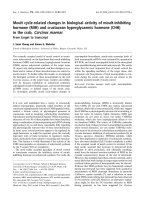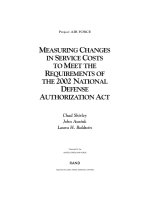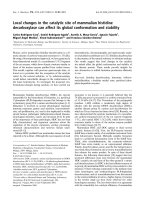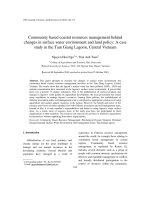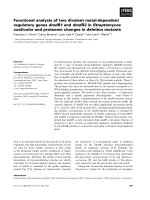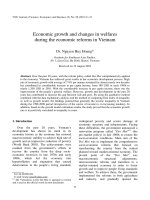Changes in refraction and biometry in emmetropic and myopic children the SCORM study
Bạn đang xem bản rút gọn của tài liệu. Xem và tải ngay bản đầy đủ của tài liệu tại đây (7.92 MB, 365 trang )
CHANGES IN REFRACTION AND BIOMETRY IN
EMMETROPIC AND MYOPIC CHILDREN: THE
SCORM STUDY
WONG HWEE BEE
(MASTER OF SCIENCE (STATISTICS), NUS)
A THESIS SUBMITTED FOR THE DEGREE OF DOCTOR OF PHILOSOPHY
DEPARTMENT OF EPIDEMIOLOGY AND PUBLIC HEALTH, YONG LOO LIN
SCHOOL OF MEDICINE, NATIONAL UNIVERSITY OF SINGAPORE
2011
i
Acknowledgements
I would like to offer my most sincere gratitude to my supervisor, Professor
Saw Seang Mei, whose encouragement, guidance and support from the initial to the
final phase of my PhD study enabled me to develop an understanding of the subject.
Her wisdom, knowledge and commitment to the highest standards inspired and
motivated me.
I also owe my deepest gratitude to my co-supervisors, Professor David Machin
and A/Prof Tan Say Beng. I could never have embarked and started my doctoral
study without their assistance and encouragement. They have supported me
throughout my research with their patience and knowledge while giving me freedom
in approaching the projects. I attribute my PhD degree to my supervisors’
encouragement and effort; as without them, this dissertation would not have been
possible.
I gratefully thank Professor Wong Tien Yin for his valuable advice and insight
on this work. I am thankful that in the midst of all his activities, he accepted to be the
chairman of my thesis advisory committee.
The financial support from the National Medical Research Council-Lee
Foundation is gratefully acknowledged. Besides, I would like to acknowledge
National Medical Research Council (NMRC/0975/2005) and Singapore Children
Society (RNO/059/06), as my research was supported in part by them.
Finally, I thank my family for their unflagging love and support throughout
my life. My special gratitude is due to my friends, colleagues and all those who have
helped and inspired me in any respect during the completion of this work.
ii
TABLE OF CONTENTS
SUMMARY…… I
LIST OF TABLES III
LIST OF FIGURES VI
LIST OF ABBREVIATIONS X
LIST OF PUBLICATIONS XII
LIST OF PRESENTATIONS XIII
CHAPTER 1
INTRODUCTION 1
1.1
AIMS
AND
OBJECTIVES
OF
THESIS 1
1.2
DEFINITION
OF
MYOPIA 2
1.3
PREVALENCE
OF
MYOPIA 3
1.4
RISK
FACTORS
FOR
MYOPIA 6
1.5
INTERVENTIONS
FOR
MYOPIA 7
1.6
REFRACTIVE
ERROR
AND
OCULAR
COMPONENTS 8
1.6.1
Refractive error 9
1.6.2
Axial length 10
1.6.3
Vitreous chamber depth 11
1.6.4
Anterior chamber depth 12
1.6.5
Lens thickness 13
1.6.6
Corneal radius of curvature 14
1.7
MEDICAL
AND
SOCIOECONOMIC
IMPLICATIONS
OF
MYOPIA 14
1.8
HEALTH-RELATED
QUALITY
OF
LIFE
AND
MYOPIA 16
1.8.1
Studies on quality of life and myopia 16
1.8.2
Generic instruments of HRQoL for children and adolescents 20
1.8.3
Paediatric quality of life inventory generic core scales 4.0 23
CHAPTER 2
METHODS 25
2.1
SINGAPORE
COHORT
STUDY
OF
THE
RISK
FACTORS
FOR
MYOPIA
25
iii
2.1.1
Selection of schools 25
2.1.2
Inclusion of children 25
2.1.3
Informed consent and IRB approval 26
2.1.4
Demographic and characteristic 26
2.1.5
School visits 26
2.1.6
Cross-cultural adaptation of PedsQL v4 27
2.2
DATA
COLLECTION 29
2.2.1
Visual acuity and refractive error 29
2.2.2
Ocular biometry 30
2.2.3
Socio-demographic 30
2.2.4
Height and Weight 31
2.2.5
Health-related Quality of Life 31
2.3
DEFINITIONS 32
2.3.1
Refractive error groups 32
2.3.2
Presenting visual impairment 32
2.3.3
Cross-sectional refractive error group 32
CHAPTER 3
STATISTICAL METHODOLOGY 34
3.1
MODELLING
LONGITUDINAL
DATA
IN
MYOPIA 34
3.1.1
Longitudinal data 34
3.1.2
Analysis of longitudinal data in myopia 36
3.1.3
Statistical analyses 37
3.2
EXPLORATOY
ANALYSIS 37
3.2.1
Growth trajectories 37
3.2.2
Mean response at each age 38
3.2.3
Locally weighted smoothing scatter plots 39
3.2.4
Correlation structure 40
3.3
DEVELOPMENT
OF
GROWTH
CURVE 41
3.3.1
Fractional polynomials 41
3.3.2
Selection of functional form 43
3.3.3
Marginal models and generalised estimating equations 44
3.3.4
Illustration of growth curve development 45
3.4
COMPARISONS
OF
GROWTH
CURVES 46
3.4.1
Multivariable fractional polynomial interaction 46
3.4.2
Illustration of model comparisons 47
3.5
CHANGES
IN
REFRACTION
AND
OCULAR
COMPONENTS
BEFORE
AND
AFTER
THE
ONSET
OF
MYOPIA 48
3.5.1
Exploratory analysis 48
3.5.2
FP models 48
iv
3.5.3
Piecewise models for children with newly developed myopia 49
3.5.4
Matched-emmetropia values 50
3.5.5
Instantaneous rate of change 50
3.5.6
Illustration of modelling for changes 51
3.6
COMPARISONS
OF
HEALTH-RELATED
QUALITY
OF
LIFE 52
3.6.1
Statistical analyses 52
CHAPTER 4
RESULTS 54
4.1
DEMOGRAPHIC
AND
CHARACTERISTICS
OF
STUDY
SUBJECTS . 54
4.2
GROWTH
CURVES
OF
HEIGHTS,
SE
OF
REFRACTIVE
ERROR
AND
OCULAR
COMPONENTS 54
4.2.1
Heights 54
4.2.2
Spherical equivalent of refractive error 55
4.2.3
Axial length 55
4.2.4
Vitreous chamber depth 56
4.2.5
Anterior chamber depth 57
4.2.6
Lens thickness 58
4.2.7
Corneal radius of curvature 59
4.3
REFRACTIVE
ERROR,
OCULAR
COMPONENTS
BEFORE
AND
AFTER
THE
ONSET
OF
MYOPIA 59
4.3.1
Spherical equivalent of refractive error 60
4.3.2
Axial length 62
4.3.3
Vitreous chamber depth 63
4.3.4
Anterior chamber depth 64
4.3.5
Lens thickness 65
4.3.6
Corneal radius of curvature 66
4.4
COMPARISONS
OF
HEALTH-RELATED
QUALITY
OF
LIFE 67
4.4.1
Characteristics of children attended eye examination 2005 / 2006 67
4.4.2
Presenting visual impairment and refractive error in 2005 / 2006 67
4.4.3
Five refractive error groups 70
4.4.4
Concordance and agreement 72
CHAPTER 5
DISCUSSION 74
5.1
SUMMARY
OF
FINDINGS 74
5.2
OCULAR
COMPONENTS
GROWTH
CURVE 75
5.3
REFRACTION
AND
OCULAR
COMPONENTS
BEFORE
AND
AFTER
THE
ONSET
OF
MYOPIA 81
v
5.4
HEALTH-RELATED
QUALITY
OF
LIFE 85
5.5
SIGNIFICANCE
OF
FINDINGS 90
BIBLIOGRAPHY 92
APPENDICES… 141
i
SUMMARY
Myopia is a major public health problem and the prevalence of myopia in
Singaporean children is one of the highest worldwide. A better understanding of the
refraction and ocular components developments during childhood will enable better
public health interventions for the prevention of onset and progression of myopia in
children and adolescents.
Yearly cycloplegic refraction and ocular biometry measures collected from the
school-aged children enrolled in The Singapore Cohort study Of the Risk factors for
Myopia (SCORM) throughout the children’s elementary education were analysed.
The children were classified into one of five refractive error groups based on the
spherical equivalent of the randomly selected eye, measured during their ages of 6 to
13 years old for: persistent hyperopia, emmetropising hyperopia, persistent
emmetropia, newly developed myopia and persistent myopia.
The overall aim of this thesis is to evaluate the ocular biometry growth,
refractive error pattern and their correlations with quality of life in Singapore school-
aged children. The aims include: i) To examine the changes in ocular components in
children with emmetropia and those with refractive errors, including hyperopia and
myopia during their ages of 6 to 13 years old, ii) To assess the changes in refractive
error and ocular components before and after the onset of myopia among children, iii)
To illustrate and present the utility of fractional polynomial in modelling longitudinal
data in myopia, and iv) To assess the impact of presenting visual impairment and
refractive errors on health-related quality of life measures in children and adolescents
of Singapore.
ii
Our findings showed that the axial length and vitreous chamber elongated with
time with younger children showing a more rapid elongation which slowed with age.
Faster elongation of axial length and vitreous chamber over time were observed in
children with myopia when compared to those with emmetropia. There was a U-
shaped growth curve for lens thickness and inverted U-shaped curve for anterior
chamber depth. Our findings of early lens thinning followed by thickening, suggest a
two-phase growth in the lens.
The eyes were found to have more negative refractive error, to grow longer
axially, and have deeper vitreous and anterior chamber appearing at 2 to 3 years
before the myopia onset in Asian children. The differences in corneal radius of
curvature and thickness of lens were minimal between children with newly developed
myopia and emmetropia. The spherical equivalent and major ocular components
could potentially be used to predict the development of high myopia in children.
Our findings also indicated that the health-related quality of life (HRQoL) of
children and adolescents was not compromised by refractive errors. The HRQoL of
those with myopia, hyperopia, astigmatism and presenting visual impairment was not
significantly lower. Similar results were found for the HRQoL reported by their
parent proxy. Notably, our findings suggested that healthy adolescents with
presenting better-seeing eye visual impairment reported lower total, psychosocial, and
school scores. The concordance in QoL measures between adolescents with
presenting better-seeing eye visual impairment or refractive errors and their parent
proxy were small.
iii
LIST OF TABLES
Table 1 - 1
Prevalence rate of childhood myopia obtained by 16 studies in 12
countries 1
Table 1 - 2
SE measures (D) in children with myopia 3
Table 1 - 3
AL measures (mm) in children with (a) myopia and (b) emmetropia
4
Table 1 - 4
VCD (mm) in children with (a) myopia and (b) emmetropia 6
Table 1 - 5
ACD (mm) in children with (a) myopia and (b) emmetropia 7
Table 1 - 6
LT (mm) in children with (a) myopia and (b) emmetropia 8
Table 1 - 7
CR (mm) in children with myopia 9
Table 1 - 8
Studies of medical implications of myopia (a) Visual impairment, (b)
Cataract and (c) Glaucoma 10
Table 1 - 9
Characteristics of generic instruments of HRQoL for children and
adolescents 12
Table 1 - 10
Scales, reliability and validity for generic instruments of HRQoL . 13
Table 2 - 1
Demographic and baseline characteristics of children by region of
recruitment 15
Table 2 - 2
Numbers of children examined by SCORM team from 1999 to 2006
17
Table 2 - 3
List of comments from children given at the pilot testing of PedsQL
v4 child self-report 18
Table 2 - 4
List of comments from parent proxy given at the pilot testing of
PedsQL v4 parent proxy-report 20
Table 2 - 5
Definition of refractive error group 21
Table 3 - 1
Descriptive statistics of AL at each age between 6 and 12 years old
22
Table 3 - 2
Pearson’s correlation coefficients between repeated measures of AL
of children with persistent emmetropia 24
Table 3 - 3
Deviances for FP1 and FP2 models for AL of children with
persistent emmetropia 26
Table 3 - 4
Comparisons of FP models assuming different functional forms 30
iv
Table 4 - 1
Demographic and characteristics of children by refractive error
group 31
Table 4 - 2
Pattern of visits for all children between their age of 6 and 12 years
old 34
Table 4 - 3
Best-fitting FP models of ocular components for each refractive
error group 35
Table 4 - 4
Characteristics of children with newly developed myopia and
persistent emmetropia 37
Table 4 - 5
SE of children with newly developed myopia at each visit 38
Table 4 - 6
Estimated mean of children with newly developed myopia and their
matched-emmetropia at each visit 39
Table 4 - 7
Characteristics of respondents and non-respondents of parent-proxy
report 41
Table 4 - 8
Characteristics of children with presence or absence of presenting
BEVI 44
Table 4 - 9
Self-reported total and summary scores amongst children by
presence or absence of presenting BEVI 46
Table 4 - 10
Parent-proxy reported total and summary scores amongst children
by presence or absence of presenting BEVI 48
Table 4 - 11
Characteristics of children with presence or absence of worst-seeing
eye myopia 50
Table 4 - 12
Self-reported total and summary scores amongst children by
presence or absence of worst-seeing eye myopia 52
Table 4 - 13
Self-reported total and summary scores amongst healthy children
without medical problems by presence or absence of worst-seeing
eye myopia 54
Table 4 - 14
Parent-proxy reported total and summary scores amongst children
by presence or absence of worst-seeing eye myopia 56
Table 4 - 15
Parent-proxy reported total and summary scores amongst healthy
children without medical problems by presence or absence of worst-
seeing eye myopia 58
Table 4 - 16
Self-reported total and summary scores amongst children by
presence or absence of hyperopia 60
Table 4 - 17
Self-reported total and summary scores amongst children by
presence or absence of astigmatism 62
v
Table 4 - 18
Parent-proxy reported total and summary scores amongst children
by presence or absence of hyperopia 64
Table 4 - 19
Parent-proxy reported total and summary scores amongst children
by presence or absence of astigmatism 66
Table 4 - 20
Characteristics of children by refractive error groups 68
Table 4 - 21
Self-reported total and summary scale scores amongst children by
refractive error groups 71
Table 4 - 22
Self-reported total and summary scores amongst healthy children
without medical problems by refractive error groups 74
Table 4 - 23
Parent proxy-reported total and summary scale scores amongst
children by refractive error groups 76
Table 4 - 24
Parent proxy-reported total and summary scores amongst healthy
children without medical problems by refractive error groups 79
Table 4 - 25
Intra-class correlation coefficients (ICC) between child self-report
and parent proxy-report 82
Table 6 - 1
Studies using PedsQL v4 149
vi
LIST OF FIGURES
Figure 1 - 1
Growth curve for AL of children in OLSM 83
Figure 1 - 2
Growth curve for VCD of children in OLSM 84
Figure 1 - 3
Growth curve for ACD of children in OLSM 85
Figure 1 - 4
Growth curve for LT of children in OLSM 86
Figure 2 - 1
Algorithm for translation and linguistic validation for PedsQL v4
parent proxy-report (Varni, 2002) 87
Figure 3 - 1
Trajectories of AL for 10 randomly selected subjects from each
refractive error group 88
Figure 3 - 2
Mean response plots of AL 89
Figure 3 - 3
LOWESS smoothing curves of AL 90
Figure 3 - 4
Scatterplot matrix of AL for all children 91
Figure 3 - 5
Correlation between first and subsequent observations (left panel)
and second and subsequent observations (right panel) of AL 92
Figure 3 - 6
Deviances by
1
z
and
2
z
for FP1 (left panel) and FP2 (right panel)
models for AL of children with persistent emmetropia 93
Figure 3 - 7
Conventional polynomials and best-fitting FP models for AL of
children with persistent emmetropia 94
Figure 3 - 8
Raw and smoothed residuals with 95% CI of fitted models for AL of
children with persistent emmetropia 95
Figure 3 - 9
Raw and smoothed residuals with 95% CI for best-fitting FP2 model
for AL of children with persistent emmetropia 96
Figure 3 - 10
Comparison of best-fitting FP models for AL of children with
persistent emmetropia and persistent myopia 97
Figure 3 - 11
LOWESS and trajectories of AL for 10 randomly selected children
with newly developed myopia 98
Figure 3 - 12
Piecewise and best-fitting FP models with 95% CI of AL for
children with newly developed myopia 99
Figure 3 - 13
Raw and smoothed residuals with 95% CI for piecewise and best-
fitting FP models of AL for children with newly developed myopia
100
vii
Figure 3 - 14
Best-fitting FP models of different in AL for children with newly
developed myopia and their matched-emmetropia values 101
Figure 3 - 15
Fitted values and slope of change for AL of children with newly
developed myopia and their matched-emmetropia values 102
Figure 4 - 1
LOWESS and trajectories of heights for 10 randomly selected
children from each refractive error group 103
Figure 4 - 2
Best-fitting FP models of heights 104
Figure 4 - 3
LOWESS and trajectories of SE for 10 randomly selected children
from each refractive error group 105
Figure 4 - 4
Best-fitting FP models of SE 106
Figure 4 - 5
LOWESS and trajectories of AL for 10 randomly selected children
from each refractive error group 107
Figure 4 - 6
Best-fitting FP models of AL 108
Figure 4 - 7
Comparisons of AL growth pattern between refractive error groups
109
Figure 4 - 8
LOWESS and trajectories of VCD for 10 randomly selected
children from each refractive error group 110
Figure 4 - 9
Best-fitting FP models of VCD 111
Figure 4 - 10
Comparisons of VCD growth pattern between refractive error
groups 112
Figure 4 - 11
LOWESS and trajectories of ACD for 10 randomly selected
children from each refractive error group 113
Figure 4 - 12
Best-fitting FP models of ACD 114
Figure 4 - 13
Comparisons of ACD growth pattern between refractive error
groups 115
Figure 4 - 14
LOWESS and trajectories of LT for 10 randomly selected children
from each refractive error group 116
Figure 4 - 15
Best-fitting FP models of LT 117
Figure 4 - 16
Comparisons of LT growth pattern between refractive error groups
118
Figure 4 - 17
LOWESS and trajectories of CR for 10 randomly selected children
from each refractive error group 119
Figure 4 - 18
Best-fitting FP models of CR 120
viii
Figure 4 - 19
Comparisons of CR growth pattern between refractive error groups
121
Figure 4 - 20
LOWESS and trajectories of SE for 10 randomly selected children
with newly developed myopia 122
Figure 4 - 21
Best-fitting FP models of different in SE for children with newly
developed myopia and their matched-emmetropia values 123
Figure 4 - 22
Fitted values and slope of change for SE of children with newly
developed myopia and their matched-emmetropia values 124
Figure 4 - 23
LOWESS and trajectories of AL for 10 randomly selected children
with newly developed myopia 125
Figure 4 - 24
Best-fitting FP models of different in AL for children with newly
developed myopia and their matched-emmetropia values 126
Figure 4 - 25
Fitted values and slope of change for AL of children with newly
developed myopia and their matched-emmetropia values 127
Figure 4 - 26
LOWESS and trajectories of VCD for 10 randomly selected
children with newly developed myopia 128
Figure 4 - 27
Best-fitting FP models of different in VCD for children with newly
developed myopia and their matched-emmetropia values 129
Figure 4 - 28
Fitted values and slope of change for VCD of children with newly
developed myopia and their matched-emmetropia values 130
Figure 4 - 29
LOWESS and trajectories of ACD for 10 randomly selected
children with newly developed myopia 131
Figure 4 - 30
Best-fitting FP models of different in ACD for children with newly
developed myopia and their matched-emmetropia values 132
Figure 4 - 31
Fitted values and slope of change for ACD of children with newly
developed myopia and their matched-emmetropia values 133
Figure 4 - 32
LOWESS and trajectories of LT for 10 randomly selected children
with newly developed myopia 134
Figure 4 - 33
Best-fitting FP models of different in LT for children with newly
developed myopia and their matched-emmetropia values 135
Figure 4 - 34
Fitted values and slope of change for LT of children with newly
developed myopia and their matched-emmetropia values 136
Figure 4 - 35
LOWESS and trajectories of CR for 10 randomly selected children
with newly developed myopia 137
ix
Figure 4 - 36
Best-fitting FP models of different in CR for children with newly
developed myopia and their matched-emmetropia values 138
Figure 4 - 37
Fitted values and slope of change for CR of children with newly
developed myopia and their matched-emmetropia values 139
Figure 4 - 38
Bland-Altman plot for agreement between child self-reported and
parent proxy-reported total scale scores 140
x
LIST OF ABBREVIATIONS
ACD Anterior chamber depth
AL Axial length
BEVI Presenting visual acuity of > 0.3 LogMAR in the better-seeing eye
CHQ Child Health Questionnaire
CI Confidence interval
COMET Correction of Myopia Evaluation Trial
CQOL Child Quality of Life Questionnaire
CR Corneal radius of curvature
D Diopter
d.f. Degree of freedom
FP1 First-degree function fractional polynomial model
FP2 Second-degree function fractional polynomial model
FPs Fractional polynomials
GEE Generalized estimating equations
HAY How are you?
HDB Housing & Development Board
HRQoL Health-related quality of life
ICC Intra-class correlation coefficient
KINDL German Quality of Life Questionnaire
LogMAR Logarithm of the Minimum Angle of Resolution
LOWESS Locally weighted smoothing scatter plots
LT Lens thickness
Max Maximum
MFP Multivariable fractional polynomial
MFPI Multivariable fractional polynomial interaction
Min Minimum
OLSM Orinda Longitudinal Study of Myopia
PedsQL-GC Paediatric Quality of Life Inventory Generic Core Scales
PedsQL v4 PedsQL-GC version 4.0
QALY Quality Adjusted Life Years
r Pearson’s correlation coefficients
RESC Refractive Error Study in Children
xi
SCORM Singapore Cohort Of the Risk factors for Myopia
SD Standard deviation
SE Spherical equivalent
TACQOL TNO/AZL Quality of Life
UK United Kingdom
USA United States of America
VCD Vitreous chamber depth
VSF Vision-specific functioning
xii
LIST OF PUBLICATIONS
Wong, H. B., Machin, D., Tan, S. B., Wong, T. Y. & Saw, S. M. (2009). Visual
impairment and its impact on health-related quality of life in adolescents. Am
J Ophthalmol, 147(3), 505-511 e501. (see Appendix 6)
Wong, H. B., Machin, D., Tan, S. B., Wong, T. Y. & Saw, S. M. (2010). Ocular
component growth curves among Singaporean children with different
refractive error status. Invest Ophthalmol Vis Sci, 51(3), 1341-1347. (see
Appendix 7)
Ostbye, T., Malhotra, R., Wong, H. B., Tan, S. B. & Saw, S. M. (2010). The effect of
body mass on health-related quality of life among Singaporean adolescents:
results from the SCORM study. Qual Life Res, 19(2), 167-176. (see Appendix
8)
Lamoureux, E. L. & Wong, H. B. (2010). Quality of life and myopia. In: Beuerman,
R.W., Saw, S.M., Tan, D. T. & Wong, T.Y. (eds), Myopia: Animal models to
clinical trials, 83-87. World Scientific Publishing, Singapore. (see Appendix 9)
Wong, H. B., Machin, D., Tan, S. B., Wong, T. Y. & Saw, S. M. (2011). Are there
changes in refraction and ocular growth before the onset of myopia? Invest
Ophthalmol Vis Sci (submitted). (see Appendix 10)
xiii
LIST OF PRESENTATIONS
Wong, H.B., Saw, S.M., Tan, S.B. & Machin, D. (2006). Health-related quality of
life in Singapore myopic adolescents: A preliminary report. Oral presentation
at 11th International Myopia Conference, Singapore.
Wong, H.B., Saw, S.M., Tan, S.B. & Machin, D. (2007). Has the health-related
quality of life of adolescents been compromised due to myopia? Poster
presentation at Asia-ARVO Meeting, Singapore.
Wong, H.B., Machin, D., Tan, S.B. & Saw, S.M. (2008). Are the ocular component
growth curves of Asian myopic children different from emmetropic children?
Oral presentation at ARVO Annual Meeting, Florida, United States of
America.
Wong, H.B., Machin, D., Tan, S.B. & Saw, S.M. (2008). Does the ocular component
of Singaporean myopic children grow differently from emmetropic children?
Oral presentation at COFM 60th Anniversary Scientific Symposium,
Singapore
Wong, H.B., Machin, D., Tan, S.B., Wong, T.Y. & Saw, S.M. (2011). Ocular
component growth curves of children with myopia, hyperopia and emmetropia
in Singapore. Oral presentation at Asia-ARVO Meeting, Singapore.
Wong, H.B., Machin, D., Tan, S.B., Wong, T.Y. & Saw, S.M. (2011). Change in
refractive error and ocular components before and after the onset of myopia
among Singapore children. Poster presentation at ARVO Annual Meeting,
Florida, United States of America.
1
CHAPTER 1 INTRODUCTION
1.1 AIMS AND OBJECTIVES OF THESIS
The overall aim of this thesis is to evaluate the ocular biometry growth,
refractive error pattern and correlations with quality of life in Singapore school-aged
children.
Aim 1: To examine the changes in ocular components in Singapore children
with different refractive errors from ages of 6 to 13 years
Aim 2: To determine the changes in refractive error and ocular components
before and after the onset of myopia among the Singapore children who developed
myopia between ages 6 to 13 years
Aim 3: To illustrate and present the utility of fractional polynomial in
modelling longitudinal data in myopia
Aim 4: To assess the impact of presenting better-seeing eye visual impairment
and refractive errors on health-related quality of life measures in children and
adolescents of Singapore
2
1.2 DEFINITION OF MYOPIA
Myopia, commonly referred to as near- or short-sightedness, is the most
common type of refractive error. It is one of the major causes of visual disability
throughout the world. Uncorrected refractive errors that is myopia, hyperopia or
astigmatism were ranked second, after cataract in the leading causes of blindness and
vision impairment by the World Health Organisation.(World Health Organisation,
2009) Myopia is a complex ocular disease, in which both hereditary and
environmental factors (such as parental myopia, near work, outdoor activities, stature,
parental smoking and intelligent quotient) contribute to the development of myopia.
Unfortunately, the cause of myopia largely remains elusive.
Myopia is defined as that state of refraction in which parallel rays of light
from an object are brought to focus anterior to the retina and thus the distant object
cannot be perceived distinctly. Emmetropia is a state of refraction in which the image
is focused perfectly on the retina. When the image is focused behind the retina, this is
described as hyperopia. Most infants are hyperopic at birth and as the eye grows in
the subsequent years, they become less hyperopic as their ocular axis elongates, with
thinning of the lens and flattening of the cornea. In general, this will lead to
emmetropia by age 8 to 10 years.(Hosaka, 1988) This process is now generally
described as emmetropisation and it is a regulating process which seeks to reproduce
the theoretically perfect eye, by which an excess of one constituent is balanced by
moderation in another. The eventual refractive states of the eyes are ranging from the
greatest degree of hyperopia through emmetropia to the greatest degree of myopia.
The refraction of the eye is determined by corneal power, anterior chamber
depth, lens power and the axial length of the globe.(Curtin, 1985) The total refractive
3
power of the eye results from the additive powers of the cornea and lens as modified
slightly by the anterior chamber depth. The correlation of this refractive power and
axial diameter of the globe determines the refractive state of the eye. In those with
myopia, the posterior focus point which is ascertained by the refractive power, lies in
front of the retina. This condition may occur as the result of: i) an excess of corneal
power, lens power or both for a normal axial length, or ii) the axial length being
longer than normal or merely longer than that which is compatible with the refractive
power of the normal eye.
Refractive error is commonly measured as spherical equivalent (SE) in diopter
(D) on a continuous scale and SE is defined as sphere power + half negative cylinder
power. In epidemiological studies, the myopia is measured by the spherical power in
diopters of the diverging lens needed to focus light onto the retina. To date, however,
there is no universally accepted definition of myopia. Commonly used definitions
include SE of at least –0.5, –0.75 or –1.0 D. Other classifications that have been used
include ‘moderate myopia’ defined as SE of at least –3.0 D, and ‘high myopia’
defined as SE of at least –6.0, –8.0 or –10.0 D.
1.3 PREVALENCE OF MYOPIA
Myopia is an ocular disorder of major public health problem in many East
Asian urban cities, especially in Singapore, Taiwan and Japan.(Saw, Katz, Schein, et
al., 1996) A study conducted in Taiwan found that 95.9% of university freshmen
were myopic.(T. J. Wang, Chiang, Wang, et al., 2008) In Singapore, a high myopia
prevalence rate was reported to be 79.3% among a cohort of 15,095 military
conscripts, while a prevalence rate of 38.7% was observed among the Chinese aged
40 to 79 years in the Tanjong Pagar district.(Wong, Foster, Hee, et al., 2000; Wu, Seet,
4
Yap, et al., 2001) The Tajimi study in Japan showed a higher prevalence rate of
41.8% in adults aged 40 years and older.(Sawada, Tomidokoro, Araie, et al., 2008)
The prevalence of myopia in adults is higher in these Asian countries when compared
to other parts of the world, including the United States of America (USA) (26.2% in
adults aged 43 to 84 years in Beaver Dam Eye Study; 22.7% in adults aged 40 years
and older in Baltimore Eye Survey), China (26.7% in adults aged 30 years and older
in Handan Eye Study; 22.9% in adults aged 40 years and older in Beijing Eye Study),
Bangladesh (22.1% in adults aged 30 years and older in National Blindness and Low
Vision Survey of Bangladesh), Australia (15% in adults aged 49 to 97 years in Blue
Mountains Study).(Attebo, Ivers & Mitchell, 1999; Bourne, Dineen, Ali, et al., 2004;
Katz, Tielsch & Sommer, 1997; Y. B. Liang, Wong, Sun, et al., 2009; Q. Wang, Klein,
Klein & Moss, 1994; Xu, Li, Cui, et al., 2005)
Myopia is one of the most common childhood ocular diseases. Several
population-based or community-based epidemiological studies on the prevalence rate
of myopia in children and adolescents have been conducted in different ethnic and
cultural groups over the past two decades. These studies are summarised in Table 1 -
1. The prevalence of childhood myopia varies in different parts of the world. A high
prevalence has also been reported in East Asian cities, especially amongst those of
Chinese origin in Taiwan, Hong Kong and Singapore. One of the earliest population-
based studies conducted in 11,178 Taiwanese school students aged 7 to 18 estimated
the prevalence of myopia increased from 12.0% at the age of 7 to 56% at the age of
12.(Lin, Shih, Tsai, et al., 1999) The prevalence became 84% at the age of 16 and this
rate remained unchanged until the age of 18. A school-based study of 7,560 students
aged 5 to 16 in Hong Kong showed a higher prevalence of 28.9% at the age of 7.(Fan,
Lam, Lam, et al., 2004) More than half (53%) of their children have myopia beyond
5
the age of 11. Similar high prevalence rate at the age of 7 (29%) was reported in a
school-based study of 1,453 Singapore Chinese children.(Saw, Carkeet, Chia, et al.,
2002) These children developed myopia much earlier when compared to children in
Taiwan and Hong Kong. Half of the Singaporean children have developed myopia by
the age of 9.
The international population-based Refractive Error Study in Children (RESC)
programme conducted in eight sites from six countries has provided representative
and comparative data for the prevalence of refractive error in school children aged 5
to 15 years (Table 1 - 1). The prevalence rate of myopia was 21.6% in a semirural
cohort of China(Zhao, Pan, Sui, et al., 2000), while a higher prevalence rate of 38.1%
was found in a urban cohort(He, Zeng, Liu, et al., 2004). The predominate Malay
population in an urban area of Malaysia had a slightly lower myopia prevalence rate
of 20.7%.(Goh, Abqariyah, Pokharel & Ellwein, 2005) In contrast to the children of
Chinese origin, a much lower prevalence of myopia was found in other RESC surveys
conducted in a rural area of Nepal (1.2%)(Pokharel, Negrel, Munoz & Ellwein, 2000),
rural (4.1%)(Dandona, Dandona, Srinivas, et al., 2002) and urban (7.4%)(Murthy,
Gupta, Ellwein, et al., 2002) India, urban Chile (7.3%)(Maul, Barroso, Munoz, et al.,
2000), and a semirural / urban area of South Africa (4.0%)(Naidoo, Raghunandan,
Mashige, et al., 2003).
The prevalence of myopia among 1,777 secondary school students aged 12 to
17 years in urban Amman, Jordan was 17.6%.(Khader, Batayha, Abdul-Aziz & Al-
Shiekh-Khalil, 2006) In a communities-based study of refractive error among
Caucasian children and adolescents in the USA, aged 5 to 17 years, 9.2% of them had
SE < –0.75D.(Kleinstein, Jones, Hullett, et al., 2003) Another community-based
6
study in 2,583 American children and adolescents aged 6 to 14 years reported that
11.6% had SE < –0.5 D and 10.1% had SE < –0.75 D.(Zadnik, Manny, Yu, et al.,
2003) A population-based study conducted in 2,340 Australian adolescents aged 11 to
14 years has reported a similar rate of 11.9%.(Ip, Huynh, Robaei, et al., 2008)
However, a lower prevalence rate of 1.4% was reported among younger children aged
5 to 8 years in another Australia community-based study.(Ojaimi, Rose, Morgan, et al.,
2005)
1.4 RISK FACTORS FOR MYOPIA
Both hereditary and environmental factors have been associated with the
development of myopia.(Mutti, Zadnik & Adams, 1996; Saw, Katz, Schein, et al.,
1996; Wallman, 1994) Multiple studies produced lines of evidence all point to a
hereditary aetiology for myopia. Twin studies provide the strongest conclusive
evidence that significantly more concordant in myopia as well as ocular components
(axial length, corneal radius of curvature and lens power) among monozygotic twins
when compared to dizygotic twins.(C. J. Chen, Cohen & Diamond, 1985; Cohen,
1983; Dirani, Chamberlain, Shekar, et al., 2006; Hammond, Snieder, Gilbert &
Spector, 2001; Lyhne, Sjolie, Kyvik & Green, 2001) A parental history of myopia is
associated with higher risk of development of myopia in children.(Ip, Huynh, Robaei,
et al., 2008; D. S. Lam, Fan, Lam, et al., 2008; Saw, Carkeet, Chia, et al., 2002;
Zadnik, Satariano, Mutti, et al., 1994) In addition, several myopia loci have been
identified for a range of myopia severities in genetic studies.(C. Y. Chen, Stankovich,
Scurrah, et al., 2007; Klein, Duggal, Lee, et al., 2007; Schwartz, Haim & Skarsholm,
1990; Young, Ronan, Alvear, et al., 1998; Young, Ronan, Drahozal, et al., 1998)



